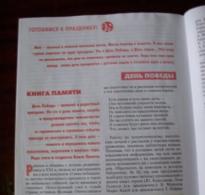Tunic made of square motifs. Crochet tunic: master class with knitting patterns Crochet tunic with square motifs
I got the idea to knit a beach tunic. I really liked these models.
For a black beach tunic
you will need: Coco yarn (100% cotton, 240 m/50 g) – 300 g black, hook No. 2.
Motif size: 14 x 14 cm.
Knit motifs according to the pattern, connecting them during knitting in accordance with the pattern. Do not join two squares at the side seams to create slits. Tie sleeves, neck, hem in one row, st. b/n.
Knitting pattern:
2.
3.
Dark blue tunic dress
Sizes of a tunic made of openwork squares: 38-38 (40-44) 46-50.
To knit a tunic from openwork squares you will need: 450 (550) 700 g of dark blue yarn (100% polyacrylic, 170 m/50 g), hook No. 3, darning needle.
Dark blue tunic-dress made of openwork squares
Openwork square: knit a chain of 6 air loops and close it with 1 connecting stitch into a ring. Next, knit in circular rows according to the pattern. Perform 1 time for square A from the 1st to the 9th row, for square B - from the 1st to the 10th row. and for square C - from the 1st to the 11th row.
Openwork motif: knit like an openwork square, but from the 5th row. knit in straight and reverse rows, but do not perform loops on a pink background.
Knitting density: square A = 1 7 x 1 7 cm; square B = 19 x 19 cm; square C = 21 x 21 cm.
The back of the tunic is made of openwork squares: knit 15 openwork squares A (B) C and connect them into a fabric of 3 squares wide and 5 squares high. To do this, starting from the 2nd square, in the last row in the places indicated by arrows in the diagram, instead of the middle air. p. arches knit 1 connection. Art. into the corresponding arch of the previous square.
In front of a tunic of openwork squares: knit 13 openwork squares A (B) C and 1 openwork motif and combine them into a fabric according to the pattern.
Tunic sleeves made of openwork squares: knit 4 openwork squares A (B) C and connect them into a fabric of 2 squares wide and 2 squares high. For sleeve bevels, tie the side edges along the pattern with straight and reverse rows of air arches. n, as in an openwork motif. After 6 r. finish the work.
Assembling a tunic from openwork squares: sew shoulder seams; sew in sleeves, sew sleeve seams and side seams, leaving unstitched for 30 cm cuts. Tie 1 p. semi-st.
1.
2.
3.
Bright squares formed the basis of a charming model - a warm tunic made of wool.
Dimensions: 38(40)42(44)
You will need:
- yarn Novita 7 Veljes-ta (75% wool, 25% polyamide, 100 m/50 g) - 550(600)650(700) g black (099), 350(400)450(500) g of similar yarn in different colors (burgundy red (587), terraa (644), red (549), dark green (391), orange (278), lilac (766), blue (124), denim (160), white (011), green (322), purple (573),
- hook No. 3.5-4
- knitting needles No. 4-4.5.
Front stitch: front rows - front loops, purl rows - purl loops.
Knitting density: 18 sts x 26 rows = 10x10 cm.
Size of one square: 13x13 cm.
Description of knitting a tunic
Hem:
Knit according to the pattern of 40 (45) 50 (55) squares, alternating different colors from the 1st to 4th rows, knit the 5th row with black yarn. Lightly steam the squares. Connect the squares into a circle using black yarn. way: turn the squares to be joined face up, place them on a horizontal surface, sew the edges together.
Upper back:
Slip along the top of the hem on one side, marked in the diagram, between the side seams, with black yarn, 76(85)94(103) sts and knit 1 row along the wrong side in stockinette stitch. Continue knitting faces. satin stitch At a height of 3(4)4(5) cm, close each 2nd row of 1x4(4)5(5) p., 1(2)2(3)x2 p. and 3x1 p. for the armhole ru-kavas on both sides. = 58(63)70(75) p. When the armhole of the sleeve is 17(18)19(20) cm, close the trail. row on the front side, middle 36(35)36(37) stitches for the neckline and knit the row to the end. Set aside the stitches on the right side and knit the left half first. When the sleeve armhole height is 20(21)22(23) cm, close off 11(14)17(19) shoulder stitches. Knit the second half of the neckline in the same way.
Upper front:
Knit in the same way as the top of the back until the height of the sleeve armhole is 5 (6) 7 (8) cm. Close behind the trace. row on the front side, middle 36(35)36(37) stitches for the neckline and knit the row to the end. Set the stitches aside on the right side and knit one half of the neck first. When the sleeve armhole height is 20 (21) 22 (23) cm, close off 11 (14) 17 (19) shoulder stitches. Knit the second half of the neckline in the same way.
Sleeves:
Tie according to the pattern and connect 4 squares together. Slip off 48(48)50(50) sts along the top edges of the squares with black yarn and knit 1 row from the wrong side of the product using stockinette stitch. Continue knitting faces. stitch, adding on both sides first every 6th row 7(6)5(2)x1 p., then every 4th row 0(3)5(10)x1 p.= 62(66)70(74) p. When you knit 19(20)21(22) cm in satin stitch, close off each 2nd row on both sides with 1x4(4)5(5) p., 3x2 p., 13(14)15(16)x1 p. and 1x2 p. Cast off the remaining stitches. Knit the second sleeve in the same way.
Assembly:
Lay the product on a horizontal surface with the wrong side up, wet it and let it dry. Sew shoulder seams. Sew the side seams of the top and the sleeve seams. Sew the sleeves to the armholes. Fasten the black thread 1 tbsp. b/n to the shoulder seam and tie the neck first 1 row st. b/n, then next. way: tie 3 air. p. and 2 tbsp. s/n to the beginning of the chain, skip 2 tbsp. b/n, *knit in the next. clause 3 art. s/n, skip 2 tbsp. b/n*, repeat *-*.
Pattern and pattern for knitting a tunic:

If you know how to crochet or just want to learn how to knit and are taking your first steps in the world of knitting, then this article is for you. So, you want to crochet a tunic from motifs. This is the simplest thing that can be, and today we will see this by looking at an easy and understandable master class.
What is motive? This is a knitting element that is repeated many times to create the finished product. Square motifs are used to knit blankets, capes, bags and much more. There are motifs of various forms. There are motifs that are used in Venetian lace and Irish knitting, there are many of them and it is very convenient for beginner knitters. Such motifs will be uniform, and the finished product will never give away a beginner in appearance. Today we will look at how to knit a tunic.
Variety of options
The main task is to learn how to knit motifs. Here, for example, is a video tutorial on knitting a motif:
From such motifs we get such a wonderful summer tunic:

Schemes of motifs and their photographs in finished form will be posted here:
This tunic is made from separately related motifs:




This tunic called “Poppies” is knitted from motifs.

To knit it you need 500 g of yarn, hook number 3.5. The color motifs are connected according to the scheme:

In the diagram you can see on what principle knitted motifs are assembled and how to tie the bottom and neck of a tunic that is already ready and assembled from motifs.
Below is a tunic made from triangular motifs. Assembly diagram and knitting pattern for the motif. From the diagram it is clear that we will need to knit 55 triangles to create just such a tunic; based on the principle of connection, you can understand how to do this correctly and knit a much longer product. The main thing is that we are given a principle and example of work that is easy to navigate.

Another tunic model. It’s convenient that in one place you can find both a diagram and how to correctly assemble the motifs into a finished product.

This delicate tunic is knitted from the same motifs.

To create it you will need 300 g of light-colored yarn and 100 g of brown yarn. Yarn composition: 100% cotton. Hook number 3.5.
We will knit the motif according to the pattern below. We start knitting with brown yarn, we will knit 4 rows with it, and from the fifth row we will knit with light yarn. The size of the finished motif is 12.5 cm in diameter.

If the length of the tunic suits you, then to create it you will need to crochet 62 motifs. Then the motives need to be combined. The connection points are indicated in the diagram; you will also need to make the shoulder and side seams of the tunic. Tie the neckline with 2 rows of stitches with 6 yarn overs, brown yarn. The sleeves need to be tied in the same way. And tie the bottom edge of the finished tunic with 2 rows of single crochets. A belt will also look good in this model. To create it you need to cast a chain of 220 air loops. If you tie such a belt with single crochets, it will look thicker. Pull the finished belt into the holes of the tunic, which are present in the pattern, along the waist line. Our chic tunic is ready!
There is another tunic model knitted using square motifs.

For example, here is a photograph:

Depending on your threads with which you knit square motifs, you will get a tunic of completely different colors. The main thing is to follow the knitting pattern and knit the right amount so that the tunic is loose and meets our expectations in length.
For such a tunic, you can safely use various leftover yarn, which is already a pity to throw away and for some large product there is not enough of it. And here they are perfect. It is desirable that the threads match each other in thickness, otherwise we will end up with square motifs of different sizes, and then because of this, when sewing the motifs together, crooked seams will occur and the tunic as a whole will be skewed. So we try to find threads of the same thickness. Based on the thickness of the thread, select the appropriate hook. In this version we have two motifs that are similar to each other; they alternate in a checkerboard pattern. The square motifs are connected to each other using arches made of air loops, as indicated in the diagram. It would be better to tie the neck with twisted single crochets.
Here is another wonderful summer tunic. You can figure it out using the diagram. The length of the tunic is 80 cm, the chest circumference is 102 cm. The tunic is openwork, cheerful colors. Will be relevant in the summer. It is better to knit it from natural threads.

The knitting pattern is very clear. Just double crochets and chain stitches.

We will also knit a yoke on top of the tunic. You need to knit 20 rows of the yoke up to the shoulders, so another 20 rows according to the pattern and this will be the back of the yoke.
This is the back of the yoke in the diagram. It can be seen that after the 11th row the knitting is divided; this is done for cutting the neckline.

This is the front of the yoke:

We also see more flower motifs, they are also knitted and used to combine all the motifs into a single tunic.
We will need 30 motifs for knitting a tunic and another 50 flower motifs. We collect everything according to the diagram and rejoice at such a wonderful thing in our wardrobe.
Video on the topic of the article
Openwork squares with a mesh pattern and a flower in the center create a beautiful canvas with intersected lines. A tunic made of openwork squares is ideal for a summer holiday at sea.
Size: 40
You will need: 350 g of white yarn Filo di Scozia Profilo: hook number 1.5.
Description of crochet tunic:
The pullover consists of 39 squares (19 for the front and 20 for the back), which are knitted separately and gradually joined together in accordance with the pattern.

Before: for the first square, crochet number 1.5 with white thread, knit the initial chain of 6 air. p., close it in a circle by making 1 connection. Art. in the last air chains, and then knit in this circle as follows. 1st circular route: 4 air. p. (= 1st st. s/2n), 23 st. s/2n. 1 connection st in 4th air. lifting point. From the 2nd roundabout. knit according to the pattern. Perform the second square as the 1st, and then connect the squares to each other during the 10th circular row. as follows: 1 air. p. (= 1st st. b/n), * 7 air. p., 1 tbsp. b/n in the next arch *, repeat from * to * 6 times, 7 air. p., while skipping 3 tbsp. s/2n, perform 3 tbsp in the corner arch. s/2n, 2 air. p., 1 connection Art. in the corresponding corner arch of the first square, 2 air. p. and 3 tbsp. s/2n; ** 3 air. p., 1 tbsp. b/n in the corresponding arch of the first square, 3 air. p., 1 tbsp. b/n in the next arch of the second square **. repeat from ** to ** 7 times, 3 air. p., 1 tbsp. b/n in the corresponding arch of the first square, 3 air stitches, skip 3 tbsp. s/2n, perform 3 tbsp in the corner arch. s/2n. 2 air p., 1 connection Art. in the corresponding corner arch of the first square, 2 air. p. and 3 tbsp. s/2n; the rest of the 10th roundabout. knit as for the first square.
Working in this way and following the diagram for connecting the squares in series, arrange them in accordance with the pattern.

Back: knit as before, placing the squares as indicated on the pattern. To avoid side and shoulder seams, for the squares highlighted in gray in the diagram, during the execution of the 10th circular row. Connect each square with the corresponding front square.
Assembly: to finish the bottom edge of the tunic, attach a thread to the junction of two squares with hook No. 1.5 using 1 connection. Art. and knit the border, following pattern 2. Having completed the circular row, cut and fasten the thread. Tie the lower edges of the sleeves in the same way. Attach the thread to the neckline with a hook No. 1.5 using 1 connection. Art. to the center of the arch in front of the corner and knit, following pattern 3. Having completed the 2nd round. cut and fasten the thread.







